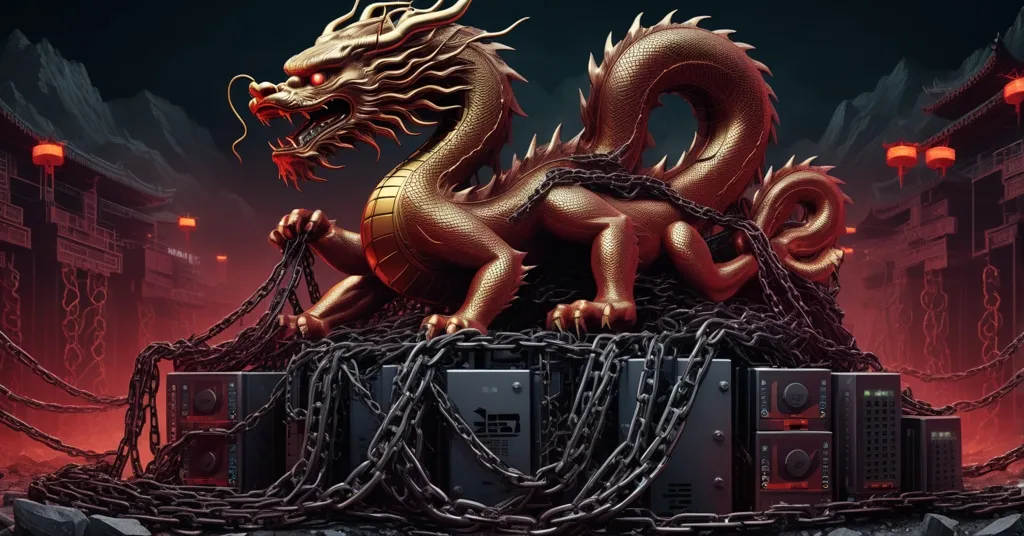China’s Rare Earth Export Curbs Hit Bitcoin Mining and Global Tech Hard

China’s Rare Earth Export Controls Disrupt Bitcoin Mining and Global Tech Supply Chains
China’s latest export restrictions on rare earths have slammed its domestic magnet manufacturers, sending ripples through global tech industries and even touching the crypto space. Implemented in April 2024 as a jab at U.S. tariffs, these controls have triggered a staggering 75% drop in magnet exports, leaving producers drowning in inventory and struggling with bureaucratic red tape. With rare earth magnets being key to everything from electric vehicles (EVs) to Bitcoin mining hardware, this crisis is a wake-up call for decentralized tech advocates about the fragility of centralized supply chains.
- Export Collapse: A 75% plunge in magnet exports since April 2024 due to China’s retaliatory policies against U.S. tariffs.
- Global Dependency: China supplies 90% of the world’s rare earth magnets, now choked by licensing delays and inventory pileups.
- Crypto Impact: Bitcoin mining hardware and blockchain infrastructure face supply risks, threatening costs and scalability.
China’s Stranglehold: The Numbers Behind the Crisis
Let’s start with the raw reality. China produces about 90% of the world’s rare earth magnets—tiny but mighty components essential for high-tech gear like EV motors, wind turbines, and the cooling fans in Bitcoin mining rigs. These aren’t just fancy gadgets; they’re the lifeblood of modern innovation. But since April 2024, when China slapped export restrictions on rare earths in response to U.S. tariffs, the industry has been gut-punched. Within two months, magnet exports plummeted by 75%, a devastating blow for a sector where the 11 largest listed producers relied on exports for 18% to 50% of their 2024 revenues. That’s not pocket change—that’s survival.
The fallout is ugly. Warehouses are overflowing with unsold stock, as reported by the Baotou Rare Earth Products Exchange, which labeled this a “crisis” for local magnet makers. Smaller and mid-sized producers have cut output by 15% just to stay afloat, while others brace for potentially crippling financial hits. And it’s not just about exports—domestic demand in China is crumbling too, with a slowing economy and EV price wars slashing orders. Ellie Saklatvala, Head of Metal Pricing at Argus, nailed the predicament:
“Their sales are now being squeezed from both ends—disrupted exports and flagging domestic demand.”
For those new to the term, rare earth magnets are made from elements like neodymium and dysprosium, mined mostly in China, and they’re unmatched in strength for their size. They’re why your EV can accelerate like a beast and why data centers—crucial for blockchain networks—don’t overheat. Without them, entire industries grind to a halt. For a deeper look into this dominance, check out this overview of China’s rare earth industry.
Geopolitical Chess: A Trade War With No Winners
This mess didn’t come out of nowhere. It’s the latest move in a long-running economic feud between the U.S. and China, where tariffs and trade barriers are weapons of choice. China’s April restrictions were a direct retaliation to U.S. levies, a power play leveraging its near-monopoly on rare earths. Even after a June 27 agreement between the two nations to ease these controls, recovery is stuck in quicksand. Why? Bureaucratic nightmares with export licensing and towering unsold inventories are clogging the system. Saklatvala warned about the slow grind ahead, drawing from past patterns:
“Looking at China’s recent export controls on other critical minerals—such as antimony—it is clear that it can sometimes take longer than expected for exports to resume and normalise.”
History backs her up. China’s earlier curbs on minerals like germanium and antimony, rolled out in 2023 and 2024, still haven’t bounced back fully. Europe, for instance, is scraping by with a fraction of its pre-control antimony for automotive batteries. If rare earth magnets follow suit, we’re staring at a prolonged bottleneck. Worse, the licensing process isn’t just a temporary snag—David Abraham, Affiliate Professor at Boise State University, sees it as a permanent scar:
“In some sense, there’s no going back. The large amounts of information now required by licensing authorities represent a permanent change for the industry and will add delays and costs for producers.”
Here’s a kicker: Beijing might not hate this chaos. With hundreds of magnet manufacturers in play, consolidation could be looming, handing China tighter reins over where these materials flow. Abraham mused on the ulterior motive:
“I do not know if Beijing sees that as a bad thing, because further consolidation is helpful for controlling and understanding where materials go.”
Translation? This crisis could be a quiet win for China’s grip on global tech, even as its own exporters bleed. For more on the broader impact, here’s a detailed analysis of global supply chain disruptions caused by these policies.
Crypto Caught in the Crossfire: Bitcoin Mining at Risk
Now, let’s hit closer to home. Who knew Bitcoin miners would be sweating over magnets? Turns out, the crypto world is more tangled with China’s policies than we’d like to admit. Rare earth magnets are critical for the hard drives, cooling systems, and other components in data centers and mining rigs that keep blockchain networks like Bitcoin and Ethereum running. Think of mining hardware as a car—if a key engine part vanishes, you’re not going anywhere fast. Disruptions in magnet supply could spike costs for Application-Specific Integrated Circuits (ASICs) and GPUs, or delay production of new rigs altogether. Learn more about these supply risks for Bitcoin mining hardware.
For Bitcoin miners, especially smaller players, this isn’t just an annoyance—it’s a potential death knell. Higher hardware costs could price out independent operators, centralizing mining power in the hands of big players with deeper pockets. That’s a direct threat to network decentralization, one of Bitcoin’s core strengths. Imagine a 10-20% jump in rig prices due to magnet shortages—pure speculation, since exact figures are scarce, but industry chatter suggests it’s not far-fetched. Add that to already thin profit margins with fluctuating BTC prices, and you’ve got a recipe for hash rate drops or stalled growth. One anonymous producer didn’t sugarcoat the uncertainty:
“The impact on our export business will be huge, although it’s hard to tell exactly how much loss we will suffer.”
Bitcoin maximalists might shrug and say the protocol’s value doesn’t hinge on hardware hiccups. Fair enough—BTC has weathered storms before, from chip shortages to energy crackdowns. But let’s not kid ourselves: mining efficiency and cost directly impact network security and miner profitability. If rigs get pricier or scarcer, it’s a problem. On the flip side, could this be a weird blessing? Past shortages have pushed miners to innovate with second-hand gear or alternative cooling tech. If the crypto crowd’s scrappiness kicks in, we might see workarounds—though don’t bet on a quick fix. Community discussions, like those on Reddit about rare earth controls affecting Bitcoin mining, highlight the growing concern.
Decentralizing the Supply Chain: A Crypto Solution?
Here’s where the ethos of decentralization can shine. The rare earth debacle exposes how dangerously reliant global tech is on a single country’s whims—90% from one source? That’s the opposite of HODLing your own keys. But blockchain tech, especially on platforms like Ethereum, could offer a counterpunch. Projects like VeChain or IBM’s blockchain initiatives already focus on supply chain transparency, tracking goods from origin to endpoint. Why not apply that to rare earths? Imagine a decentralized ledger verifying magnet sourcing, cutting through China’s opacity and reducing geopolitical risk. It’s a niche, sure, but a damn vital one. For broader perspectives on this intersection, explore this discussion on rare earths and crypto mining investments.
Beyond tracking, there’s room for broader innovation. Crypto communities could rally behind recycling tech for rare earth components—data centers churn through hardware fast, so why not crowdsource sustainable solutions? Or push for open-source designs for mining rigs that sidestep magnet-heavy parts altogether. If we’re serious about effective accelerationism—ramping up progress through tech—sitting on our hands isn’t an option. Altcoins and other protocols often fill gaps Bitcoin doesn’t touch, and supply chain resilience could be their next frontier. If anyone can hack a workaround to centralized chokeholds, it’s the crypto crowd.
Market Mirage: Don’t Believe the Hype
Meanwhile, the stock market is playing mind games. Shares of listed magnet producers like Baotou Tianhe Magnetics Technology Co. and Yantai Zhenghai Magnetics tanked in April but have since clawed back some ground. Before you cheer, listen to Cory Combs, Head of Critical Mineral Research at Trivium China, who’s calling BS on the recovery:
“I can see various market outlooks, more or less negative depending on the assumptions, but none of them yield a sustainable rise in share price like we’re seeing.”
In plain speak, this rebound is speculative fluff, not a sign of real healing. Fundamentals are still trash—overflowing inventory, stalled exports, and no quick demand boost in sight. Anyone peddling rosy price predictions for these stocks is likely shilling nonsense. We’re not here to hype baseless pumps; our job is to cut through the noise with hard, cold facts, even if they bite. For a closer look at the initial market impact, see this report on magnet export drops since April 2024.
What’s Next for Crypto and Rare Earths?
Let’s face the ugly truth: China’s export controls have exposed a gaping wound in global tech supply chains, from EVs to crypto mining hardware. Bitcoin’s core promise of freedom and decentralization stands tall, but the physical infrastructure it leans on is caught in a geopolitical stranglehold. Recovery for Chinese magnet producers looks like a slog, with bureaucratic delays and consolidation potentially tightening China’s grip even further. For industries like ours, supply chain resilience isn’t just a trendy term—it’s a must. The struggles of Chinese exporters under these restrictions underscore the severity of the situation.
Yet, if there’s a silver lining, it’s this: crises breed innovation. The crypto community knows how to adapt under pressure, whether it’s dodging regulatory crackdowns or outsmarting energy costs. This rare earth mess could be the catalyst for decentralized solutions—be it blockchain-tracked sourcing or community-driven hardware hacks. We’re all for disrupting the status quo, and that means facing harsh realities head-on. So, let’s turn this vulnerability into a rallying cry. If Bitcoin and blockchain stand for anything, it’s rewriting the rules. Time to prove it.
Key Takeaways and Questions for Reflection
- How do China’s rare earth export controls affect Bitcoin mining?
They disrupt the supply of critical magnets for mining hardware and data centers, potentially hiking costs and delaying infrastructure growth for Bitcoin miners and blockchain networks. - Why is recovery dragging despite the U.S.-China agreement?
Bureaucratic hurdles in export licensing and massive unsold inventory are stalling progress, echoing slow rebounds seen with other minerals like antimony and germanium. - Can blockchain technology help solve these supply chain woes?
Yes—Ethereum-based projects and others could boost transparency in rare earth sourcing, using decentralized ledgers to track materials and lessen reliance on centralized control. - Is China’s strategy a boon or bane for global tech and crypto?
It’s a double-edged sword; while it may solidify China’s dominance through consolidation, it risks stifling innovation by choking critical supply chains, impacting everything from EVs to mining rigs.



